Orthodontic trainer – is a special type of treatment device. It enables the combination of instrumental and fusional treatment steps and increases the effectiveness of both approaches. The result is. Result Treatment with braces is more The result is more stable and the treatment process is faster.

- Orthotics for the toes
- Types of interdigital orthoses
- Manufacture of individual silicone interfinger orthoses for children and adults
- Foot orthosis for children
- 'Vreden Readings' 2019.
- INDICATIONS FOR THE USE OF ORTHOSIS
- AREAS OF APPLICATION
- Better sitting
- Ritual and body image
- Immobilization with a polymer (plastic) plaster cast
- Applying the plaster
- Polyurethane bandage (synthetic) 'Orthoforma Cast', South Korea
- Alfasplint polymer orthopedic bandage
- Care instructions for the trainer
- Application
- Types of braces for posture correction
- Indications for using a recliner
- Indications for finger and hand syndactyly surgery
- Treatment of syndactyly
Orthotics for the toes
Experts confirm that about a third of the world's population suffers from foot deformities of varying degrees and forms. This condition leads to flat feet, crooked toes, ingrown toenails, calluses, and severe joint problems.
Silicone toe orthoses are prescribed to correct various foot and toe deformities. They relieve pain, restore the correct foot position and ensure the restoration of forefoot function.
In our center, a podiatrist is responsible for making the individual orthoses. Each orthosis is made according to the individual characteristics of the foot and the existing pathology. During treatment, the podiatrist monitors the patient's progress. Monitoring makes it possible to assess the result of treatment with an individual insole and, if necessary, to carry out progressive correction.

Types of interdigital orthoses
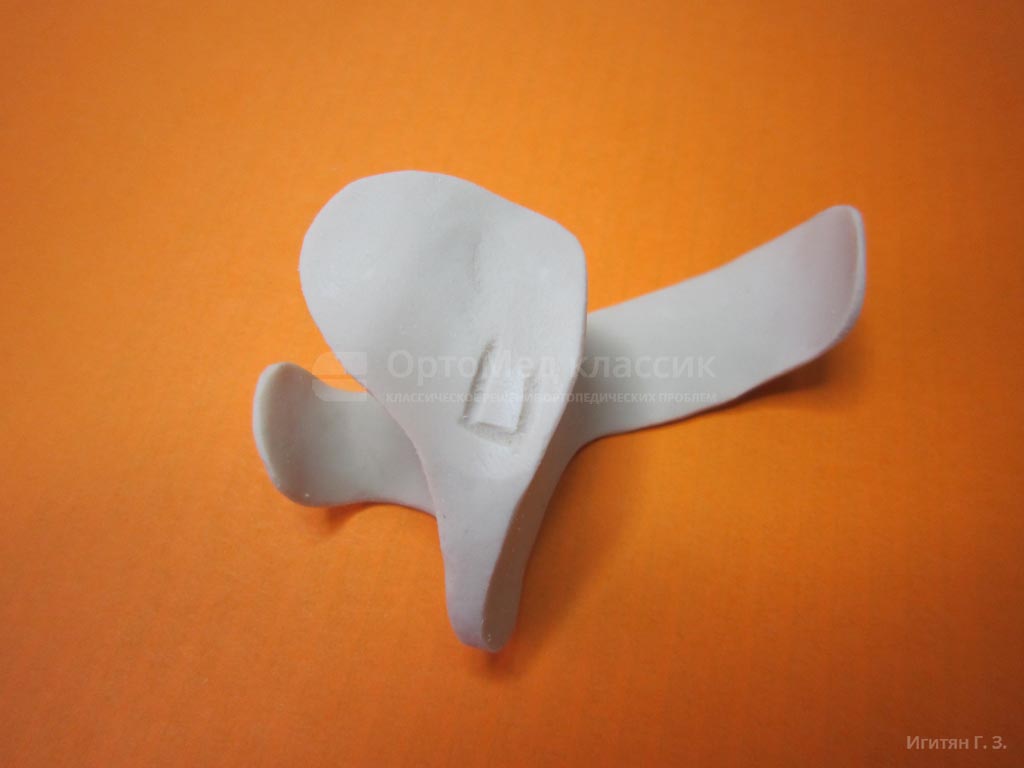
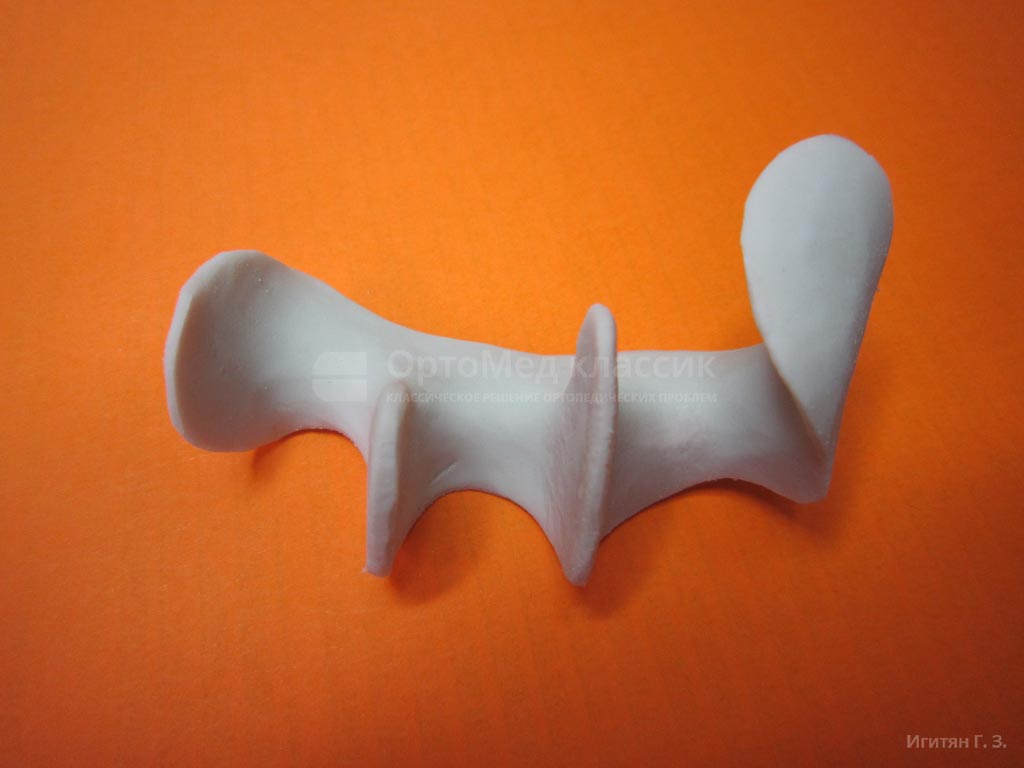
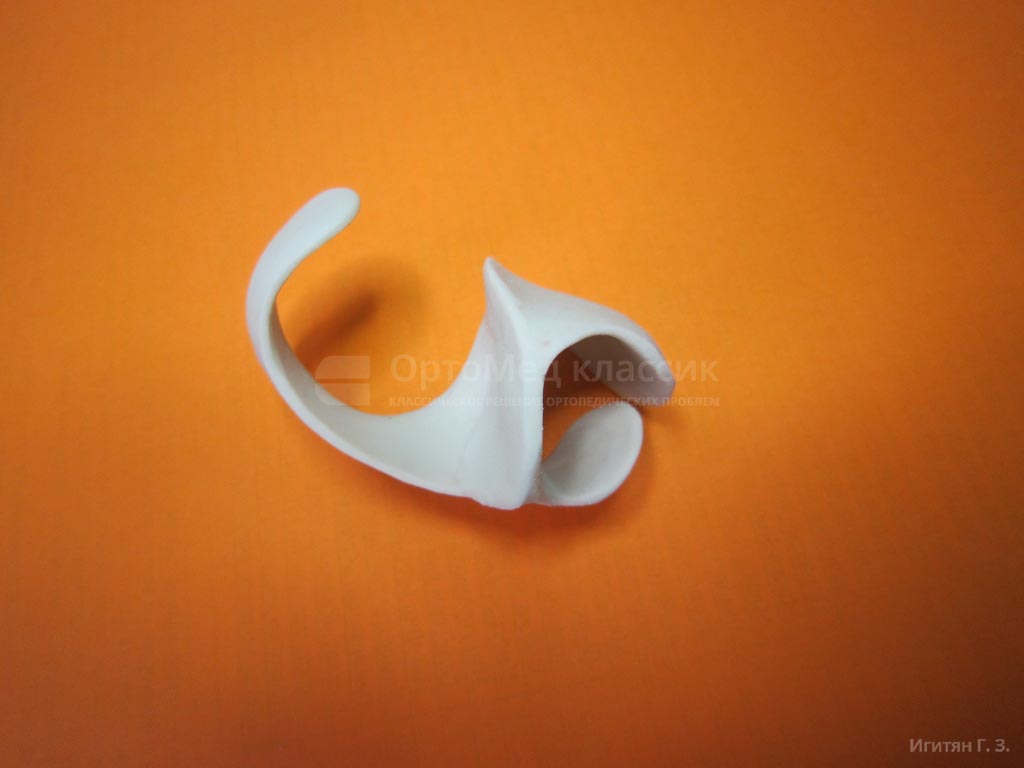
The production of the 'product – is a demanding process that requires thorough knowledge and experience of the prosthetist. During use, it is necessary to consult a specialist, correct or make a new orthosis. The orthoses are replaced on a scheduled basis every six months.
These orthoses are a means of non-surgical treatment of one or two fingers, as well as complex combined forms of finger deformities. During treatment, the pain decreases, the swelling subsides and the fingers gradually return to their normal, physiological position.
Typically, toe deformities are a result of the different types of flat feet. To achieve the greatest possible effect in treating orthopedic foot problems, insoles must be used in combination with orthoses. Computer-assisted foot diagnostics allows the specialist to see a three-dimensional image of the anomaly and create an individual insole.
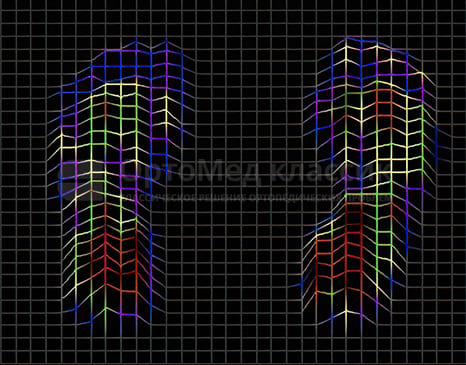
Computer-assisted 3D foot diagnostics is a state-of-the-art diagnostic test that allows you to statically and dynamically determine whether flat feet and other foot deformities are present.
The examination is carried out using a digital plantograph and allows the determination of foot parameters in color, digital and volumetric images.
The results are stored in an electronic database so that the condition of the feet and the effectiveness of the treatment can be assessed over time.
Manufacture of individual silicone interfinger orthoses for children and adults
| Service name | Price |
| Production of an individual splint orthosis with a silicone intermediate piece for wearing during the day with step correction | 2,500 to 6,500 rubles. |
| Production of an individual silicone intermediate orthosis for wearing at night with step correction | From 3,000 to 7,500 rubles. |
| Performance of a toe replacement orthosis (toe prosthesis) | From 10,000 to 20,000 p. |
| Nail prosthesis for the toe | 2,000 r. |
Foot orthosis for children
Modern orthoses for recovery after injuries or operations
When you choose a Turbocast orthosis, you provide yourself or a loved one with the greatest possible comfort and safety during treatment.
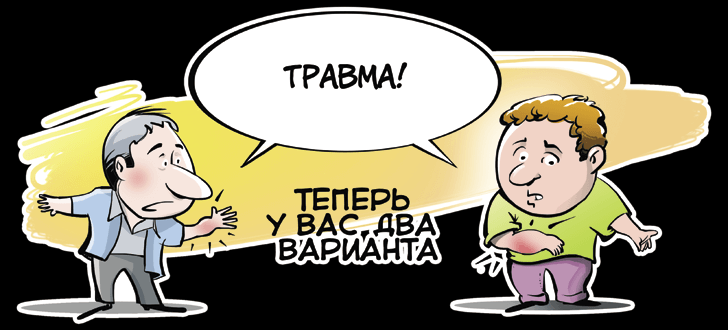
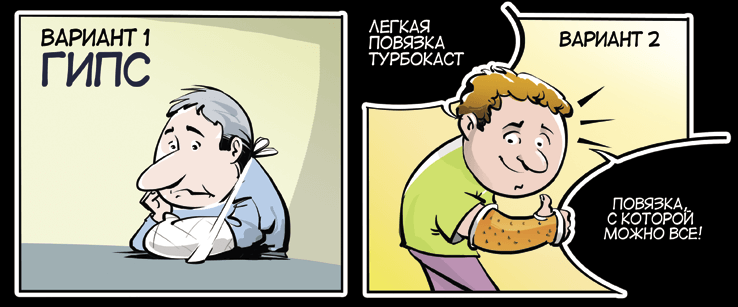
Information about Turbocast, its features, product catalog, application experiences, patient advice and much more:
vk.com/turbocastru
'Vreden Readings' 2019.
September 26-28, 2019 The annual scientific and practical conference 'Vreden's Readings' was held at the Holiday Inn Moskovskie Vorota Hotel, 97A Moskovsky pr. 'Vredener Readings' took place at the Holiday Inn Moskovskiye Vorota Hotel, St. Petersburg. There our company presented modern orthoses for convalescence after injuries and operations.
Please consult a specialist for any contraindications.
St. Petersburg,
91 Moskovsky Avenue.
Tel: +7 (812) 317-67-77
Tel.: +7 (812) 317-67-77 Hotline:
8 (800) 555-27-08
The call is free for subscribers in all regions of Russia
Turbocast in Moscow:
Endomedproekt Ltd.
Moscow, Korovinskoe sh. 1, k. 2, space. 13
Tel: +7 (495) 649-63-47
OrthoFix LLC
620100, Yekaterinburg, Sibirskiy Tract, Bldg. 12, p. 8, Bldg. 302
Telephone: 8 (992) 000-43-96
Email: [email protected]
INDICATIONS FOR THE USE OF ORTHOSIS
- osteoarthritis;
- Arthrosis;
- prevention and treatment of limb contractures in cerebral palsy;
- Spastic paresis, flaccid paresis;
- mobilization of dislocations;
- Musculoskeletal deformities;
- bones on the finger (hallus valgus);
- scoliosis grade III-IV;
- fractures;
- rehabilitation after injuries and operations;
- Chronic Pain Syndrome.
A functional orthosis with an adjustable angle of movement is indicated in postoperative rehabilitation and rehabilitation after a stroke.
AREAS OF APPLICATION
- Orthoses are used in the rehabilitation of neurological diseases. For example, spinal orthoses for scoliosis and more serious injuries to the musculoskeletal system allow immobilizing any part of the spine during complex treatment, thereby supporting the muscular corset and stopping the progression of the pathological process.
- Orthoses for cerebral palsy help keep muscle groups with increased muscle tone in the correct position and relieve them of excessive stress. Orthotics for cerebral palsy help maintain range of motion and prevent joint contractures, which occur when muscles with increased muscle tone remain in a shortened position for long periods of time.
- Orthoses for stroke patients are used in the initial phase of rehabilitation, when the patient is just learning an upright posture and the legs are bent under the weight of the body.
'Dr. EAST in Chelyabinsk produces orthopedic insoles from a unique, latest generation material – Turbocast. It is a technologically advanced, low temperature thermoplastic material that allows the creation of customized orthoses taking into account the anatomical characteristics and indications of the patient.
- Contribution. Creating an individual orthosis with Turbocast does not take much time. Each one only takes a few minutes.
- Rebuildability. Once made, the orthosis lasts a long time because it can be reused several times. Turbocast has the unique feature that it can be easily reshaped after heating to 60-70 degrees. This feature is valuable in long-term rehabilitation when orthoses may need to be adjusted more than once.
- Firm and durable. When the material is cooled to body temperature, it transforms into a solid and rigid structure that suffers no damage.
- Plasticity. Turbocast orthoses from Doctor OST, Chelyabinsk adapt to any injured area, from the toe to the back.
- Quality. The prefabricated orthoses are attached with a practical zipper. The zipper is attached to the brace with silk ties that gently touch the skin. If necessary, you can remove and put the Turbocast orthosis back on yourself without having to consult a trauma surgeon.
- Comfort. The main difference between the Turbocast orthosis and conventional plastic orthoses is the soft and velvety inner shell. Turbocast is pleasant to the touch. The orthoses made from this are worn directly on the skin. Conventional plastic orthoses must be ventilated prophylactically every 5-6 hours. Turbocast is permeable to air, so it can be worn without regular ventilation. The texture takes some getting used to and is not noticeable.
- Easy care. The Turbocast bandage is easy to care for. The material can be washed in regular warm soapy water, and you can wash the brace during rehabilitation and even go on vacation to the sea.
- No restriction on freedom of movement. For example, the Turbocast foot orthosis allows you to step on the orthosis. This is undoubtedly important.
- Security. Turbocast does not cause any allergic reactions, the material is non-toxic and completely harmless.
Better sitting
Whenever possible, occupational therapists recommend sitting or semi-sitting, especially if there is a functional wheelchair and a bed that already supports the head, back, arms and legs.
'When it comes to people with severe spasticity, more 'gathered' positions are useful when dressing,' Elena continues. – Not lying flat, but half-sitting – if we bend our legs, we make a stop for them. This position is more beneficial for both the child and the caregiver. It is best to use a functional bed that allows you to raise the headboard and all parts of the bed. A wheelchair can also do this - for example, the entire seating system can be tilted backwards with the help of gravity. Not just the backrest, but the entire seating system.
Sometimes it is because the muscle tone is very high," says Elena, "or vice versa, the high muscle tone is reduced and the child looks like a jellyfish, as if he is dehydrated. Or a very large teenager, with a lot of weight, or just big. Then it's hard to do everything sitting down. But at least let him or her be fully supported - fully on the bed, the couch, the banquette.
The same principle is recommended when you need to get dressed in a situation where neither a functional bed nor a modern stroller is available: ensure that the baby is in a stable position by placing him completely on a surface.
Ritual and body image
'A child must have certain cognitive and motor skills to be able to dress themselves or to participate in dressing,' explains Ekina Mishina. – explains Ekaterina Mishina. – For example, it must be able to find its way around the scheme of its own body.
If a child is always placed with his legs hanging off the banquet, he will perceive them as separate from his body, which is not holistic. And the caregiver's job is precisely to give the child the feeling of a whole, collected body.
Another important principle that occupational therapists always pay attention to is that the child is involved in the dressing process. The only thing he can do himself is to let him do it: take a shirt from the pile, put his hand through a sleeve, take off a sock. If the child is cognitively disturbed, you can help him with words: say, for example: E.g. 'pick up your shirt' or 'put it on your lap'. You can also physically ask the child to touch your hand and then pick it up and put it up their sleeve.
It is important that the ritual of getting dressed is the same every day. Additionally, it is not advisable to breastfeed a child with a mobility disability. Every time there is an interaction, the caregiver speaks throughout the entire process. The mother warns: We're going for a walk now. (Pause.) Now let's get dressed. (Pause.) I'll sit you down now. Then she warns about the body parts we will put on. 'Now we're going to put on some pants. I'll bend your leg. '
Immobilization with a polymer (plastic) plaster cast
The quality of fracture treatment largely depends on the effectiveness of the immobilization agents used (immobilization of the bone in the fracture area). The use of polymer (plastic) orthoses (such as the Turbocast series) opens up new possibilities in fracture treatment.
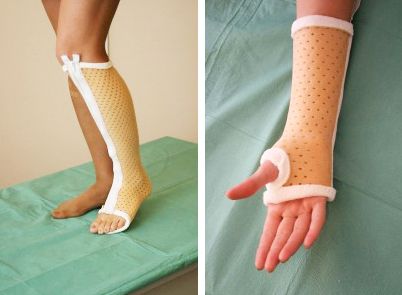
Immobilization with plastic plaster bandages in the family doctor's office
- Low weight and high strength. Turbocast plastic plaster is a thermoplastic material with a special structure that makes the plaster light and strong. Although the plastic leg cast is many times lighter than a conventional plaster cast, it surpasses it in terms of strength and hardness.
- Breathable and moisture resistant. These properties of the product prevent itching and do not irritate the underlying skin, in addition to providing protection from moisture. The patient can shower, lie on the beach and swim.
- Mimics the contours of the body. The plastic bandage ensures a perfect fit and almost no restriction of movement. The plastic cast is extremely comfortable on the foot and allows you to wear shoes and move more comfortably.
- It doesn't stick to your hair.It does not stick to the hair and the patient does not feel any pain.
- The bandage is smooth. No special stockings or insoles are required. The 'Turbocast' dressing is aesthetically pleasing and clean, odorless and dust-free.
- It does not cause any allergic reactions..
- The bandage can be easily removed and reattached if necessary (e.g. for physiotherapeutic or hygienic measures).
- The patch minimizes the risk of wounds and abrasions (prevents soft tissue atrophy).
- The material reduces the radiation dose during radiological examinations carried out to monitor treatment progress.
Applying the plaster
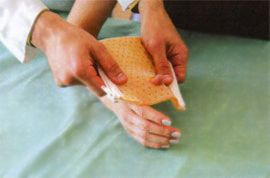
Immobilization with a plastic plaster in the doctor's office
Turbocast plastic plaster is a low temperature thermoplastic material. When heated to 60-100 °C, the material becomes malleable. On the surface it cools down to 35-45 °C within a few seconds so that it can be placed on the body. If necessary, it can be warmed up again - this way the orthosis can be shaped according to the clinical situation. Turbocast cures within 6-8 minutes and forms a strong, rigid structure.
Immobilization with plastic plaster is carried out in Moscow by traumatologists from the network of general hospitals.
Do not self-medicate. Contact our specialists who will make a correct diagnosis and prescribe treatment.
Polyurethane bandage (synthetic) 'Orthoforma Cast', South Korea

Bandage – rigid fixation and 'Orthoforma Soft Cast Soft Cast – a modern alternative to the traditional plaster cast.
Polyurethane dressing (polymer, synthetic) Orthoforma Cast and Orthoforma Soft Cast – is a new, modern bandage
a modern immobilization material for traumatic and orthopedic purposes.
Polymer bandages are used to immobilize various segments of the musculoskeletal system after trauma or operations with injuries to the bone structure and epiphyseal ligaments
(fractures, dislocations, subluxations) – it is lighter, moisture-resistant, breathable and has low radiation sensitivity.
Synthetic polyurethane dressing:
- Orthoforma Cast – rigid immobilization;
- Orthoforma Soft Cast – soft fixation (polymer dressing) differs significantly from the classic plaster cast: The polymer dressing is 5 times lighter, non-allergenic and non-toxic. The polymer bandage is breathable, which makes it more comfortable and practically irreplaceable when used on large areas of the limbs, as it does not cause maceration and itching.

A polymer immobilization dressing is not an obstacle to aqueous procedures (if the patient does not have an open wound), and a polyurethane dressing is not afraid of moisture and does not swell from wound deposits and drug solutions, and it is easy to clean and disinfect. The polymer bandage is comfortable to wear (inconspicuous under clothing).
Orthoform polyurethane bandage longgings are elastic in all directions (longitudinal, transverse, diagonal) so that the bandage adapts perfectly to the surface of the human body around bony prominences such as the kneecap, elbow, ankle and heel without kinking or folding. It is radiopaque (does not affect X-ray diagnostics). It is quick and easy to set up.
To avoid skin contact and pressure on the soft tissues, the polyurethane bandage should be applied under a stocking and rock wool (a simple gauze bandage can also be used in two passes).
The uncomfortable plaster casts that have been used for many years for broken bones, sprains and strains are a thing of the past. Many people have come to appreciate this fixation material as an alternative to uncomfortable and unsightly plaster.
Alfasplint polymer orthopedic bandage
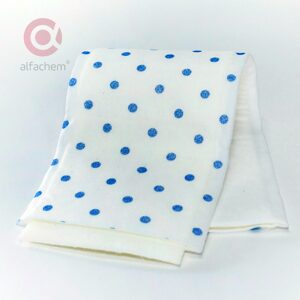
A multifunctional orthopedic product for transport, treatment and rehabilitation. Hygienic, light, individually designed, adapted to the patient, allows access to the injured body part.
Functional principle – moisten and place on the injured limb. No padding required. Practical for fractures and injuries to create immobilization bandages when rigid immobilization is not required.
Material: Outer layers are hydrophobic non-woven fabric pads. Curing layer – non-woven fabric impregnated with polyurethane resin.
Manufacturer: 'AlfaChem' Ltd, Russia

Price in rubs:
247.00 – 7.5cm x 30cm
546.00 – 7.5cm x 88cm
352.00 – 10.0 cm x 38 cm
524.00 – 10.0 cm x 75 cm
748.00 – 12.5cm x 75cm
897.00 – 12.5cm x 114cm
897.00 – 15cm x 75cm
1421.00 – 15cm x 114cm
Care instructions for the trainer
Care of the jaw trainer is very simple and does not require any special skills. It is for patients of all ages Old. Simple rules must be followed:
- Always rinse the device after removing it from your mouth Mouth.. If it gets dirty, clean the trainer with a toothbrush and toothpaste just like you brush your teeth.
- Store the product in its own container to avoid dust, dirt and accidental damage.
- Do not chew, bite or boil the device. Rinse it with warm water, not cold or hot, otherwise the plastic may be damaged.
- If the trainer is damaged, take it immediately to an orthodontist to determine whether it can continue to be used. use. The orthodontist can tell you whether you can continue to use it or whether you need to buy a new one.
Application
Aligners for teeth – are a modern and relatively painless method for treating anomalies Tooth and tooth position problems. It is prescribed by the orthodontist if there are certain dental indications, e.g. swallowing problems, misaligned teeth, but braces cannot be used. A contraindication to braces is chronic nasal breathing disorder. Nasal breathing disorders and crossbites.
Braces have many advantages: they are often chosen because of their low price and the safety of the system, as it does not damage tooth enamel and does not irritate mucous membranes. But there are also disadvantages, the most negative of which is the slow effect on the dentition. But the effect is still there. It is true that you have to choose the right product among all the varieties.
The trainer takes some getting used to and is easy to care for. However, it does more than braces: it eliminates the cause of bite problems and reduces the risk of future problems. For this reason, many orthodontists prescribe a trainer alone or along with braces.
Types of braces for posture correction
There are two main types of braces: prophylactic and therapeutic.
- The prophylactic braces have a low level of hardness. They are aimed at correcting minor anomalies and improving correct posture with straight shoulders and neck. The device is quite simple in its construction and use. It is made of natural cotton fabric with high strength. There are soft pads at the points of contact with the shoulders to prevent skin abrasion.
- Therapeutic beds are used in the later stages of deformities and pronounced postural abnormalities. This type of recliner is usually prescribed to patients with prone position, kyphosis or scoliosis, osteochondrosis and other pathologies of the spine. In this case, the orthopedic support is much stiffer. It is equipped with stiffening ribs - connecting pieces made of metal or plastic.
For particularly severe lesions, as well as for rehabilitation after injuries, a thoracolumbar corset is used, which covers and supports the entire spine.
Indications for using a recliner
The posture corrector is indicated in the following cases
- Deformities and other diseases of the thoracic spine: scoliosis, lordosis, kyphosis.
- A stooped posture that developed during childhood or adolescence. At first it receives little attention because it does not cause any discomfort and seems to be an easy problem to fix. But even at this initial stage, a corset is essential.
- Rehabilitation and restoration of spinal function after injury.
- Osteochondrosis is characterized by structural changes in the tissue of the spine. With osteochondrosis, the muscles are under constant tension. The corset helps to relax her.
- For prevention after massage and manual therapy.
- To relieve increased pressure on the spine during pregnancy. However, before using the corset, you should definitely consult your doctor, as there are contraindications to wearing the corset for pregnant women.
The use of an orthosis is also advisable in the postoperative period when the patient requires longer rehabilitation and the back muscles should remain relaxed.
The effectiveness of posture correction is increased when combined with massage, exercise therapy and other physiotherapeutic treatments.
Indications for finger and hand syndactyly surgery
A patient with upper limb syndactyly experiences psychological discomfort due to a cosmetic defect. He may complain of feelings of inadequacy, lack of communication, and lack of self-confidence. In addition, the disorder limits the normal movements of not only the fingers but also the entire limbs. As a result, the child is delayed in development, his psychomotor, intellectual and linguistic abilities are lagging behind, which prevents learning and does not allow normal self-realization in the future.
Syndactyly of the legs is also unpleasant. Although the defect can be concealed with shoes, there are many areas in which those affected feel inadequate. They refuse to visit gyms, swimming pools, saunas and beaches. At the same time, toe anomaly is rarely associated with functional impairment, so the most common reason for a visit to the doctor is the patient's desire to correct a cosmetic defect.
For the simple form, an operation between one and two years is indicated, for the complex form between five months and a year. Such early intervention prevents the delay in overall development and the emergence of complications in the form of secondary deformities.
Treatment of syndactyly
Syndactyly can only be treated through surgery. Due to the variety of forms, types and types of syndactyly, the optimal method is selected strictly based on each individual case. The aim of the operation is not only to correct the cosmetic effect, but also to improve the function of the affected limb. For complex shapes, multiple plastic surgeries are required to correct the skin, soft tissues and bones.
When planning the operation, the surgeon takes into account that the separation of the fingers must be done in stages. For example, if there is syndactyly of all or several fingers, the first and fifth fingers are separated first, then the second and third and only then the third and fourth. This is justified because it eliminates the risk of death if a major blood vessel is injured during the invasion.
Another rule that surgeons follow is not to tighten the edges of the wound; the skin should be loose. Otherwise, thickened, unsightly scars and narrowings will form, which will prevent the fingers from developing normally and lead to contractures.
Although there is no clear systematization of syndactyly surgery due to the variety of defects, five main groups can be distinguished. This includes dissection:
- The thin band between the toes without skin correction;
- skin membrane with local tissue transplantation;
- fingers fused to a skin graft using a split flap;
- Fused fingers with skin removal using local tissue and tissue grafts from another part of the body;
- with multi-stage procedures and transplants of skin, muscle and bone.
Reconstructive treatment with conservative methods such as hand/foot massage, therapeutic body training, electrical stimulation, applications begins six months after the procedure.
Read more:- Turbocast footprints.
- Turbocast Hock Price.
- ribbons for children.
- Turbocast to buy at spb.
- What are children's tunics?.
- ankle braces for children.
- knee brace.
- Turbocast Prize in St. Petersburg.
